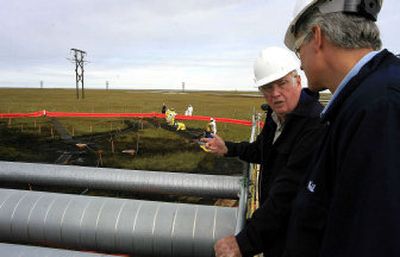BP may keep open half of Prudhoe Bay field

PRUDHOE BAY, Alaska – Federal regulators ordered BP PLC to conduct more rigorous tests of oil pipelines Thursday as the company said it might keep nearly half of the nation’s largest oil field open despite leaks and severe corrosion.
The Department of Transportation ordered four daily surveys of all pipelines as BP announced it might not have to shut down its entire Prudhoe Bay operations.
The eastern side of the field was closed Tuesday after a small spill, but about 140,000 barrels of oil continued to flow Thursday from the western side, said Craig Wiggs, a performance unit leader for BP. Before the company started shutting down operations, the field produced 400,000 barrels a day.
If the western side kept flowing, that would mean the company would be able to maintain the 140,000-barrel capacity – and possibly ramp up to 185,000 barrels – while work continues on the eastern side.
But in order to keep that oil flowing, BP must strip insulation from the pipes and conduct ultrasonic testing, the Department of Transportation’s Pipeline and Hazardous Materials Safety Administration said.
The test will give a picture of the pipe’s health that is similar to a sonogram, typically used to view a fetus in the womb.
The company also will be required to use heat-seeking infrared equipment to detect leaks and must visually inspect by foot, car or plane all 22 miles of transit lines.
The company must also pass inspections before restarting its eastern operation.
BP said it would decide by early next week how it would proceed with operations at its western field, but a spokesman did not immediately have a comment on the order from the regulators.
Wiggs said the company had initially decided to shut down the entire field because the leak on the eastern side made officials question their earlier inspections throughout the pipeline.
But now, Wiggs said, the company was rethinking whether it could keep the western line open.
“It’s a line we have the best confidence in,” Wiggs said. “We’ve spent lots of time inspecting it in March, April and May after the spill.”
The long-term plan would still be to replace the pipeline on the west side, which is where the company discovered a massive spill of up to 267,000 gallons in March.
BP also said it takes full responsibility for the lack of upkeep that led to the severe corrosion and shutdown.
“BP is the operator of the field. We’re ultimately responsible,” said Kemp Copeland, manager of the Prudhoe Bay oil field.
BP has a contract with Canadian company Acuren to provide corrosion inspections.
The eastern side of the Prudhoe Bay pipeline had not undergone a high-tech inspection called “smart pigging” since 1992, although the western side had undergone the check in 1998 and was scheduled for the test this summer.
Acuren officials did not immediately return several messages late Thursday. The Acuren companies are subsidiaries of Rockwood Service Corp., headquartered in Greenwich, Conn.
BP workers on Thursday used ultrasound to listen for signs of thinning walls in the carbon steel pipe.